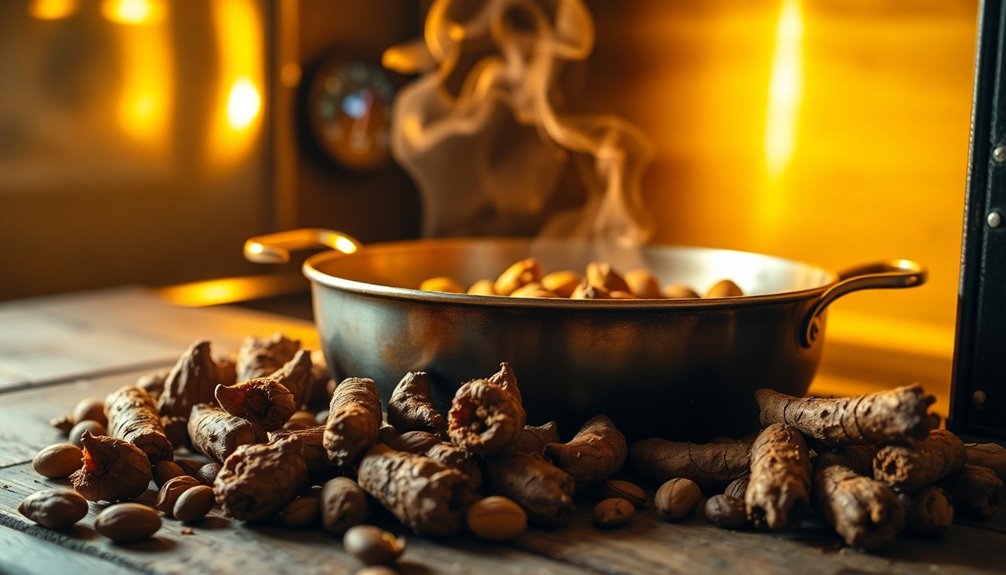To roast chicory root for coffee, start by cutting and cleaning the roots, removing any green tops. After soaking and scrubbing, slice them into pieces about 5mm thick. Spread the slices on a parchment-lined baking sheet and dry them in the oven at 200°F for 1 to 1. 5 hours. Once dried, increase the oven temperature to 300°F for roasting. Stir the roots constantly to guarantee even cooking, and they’re done when they snap easily. This method brings out the rich flavors of chicory, making it a great coffee substitute. You’ll discover more tips for brewing the perfect cup soon! Once the chicory roots are roasted, allow them to cool before grinding them into a fine powder. This will ensure that the flavors are fully released and ready to be brewed into a delicious cup of coffee. Roasting chicory root in the oven is a simple and effective way to enhance the taste and aroma of your coffee, providing a unique and satisfying beverage for any coffee lover. With just a few steps, you can enjoy the rich, robust flavors of chicory in your morning cup.
Key Takeaways
- Preheat the oven to around 300°F for optimal roasting of chicory roots.
- Ensure roots are thoroughly dried at low temperature (200°F) for 1-1.5 hours before roasting.
- Slice chicory roots into uniform pieces, approximately 5mm thick, for even roasting.
- Stir the roots constantly during roasting to promote even cooking and prevent burning.
- The finished roasted chicory should snap easily when pressed, indicating readiness.
What Is Chicory?

Chicory, a flowering plant known scientifically as Cichorium intybus, is more than just a pretty blue flower; its roots are a popular caffeine-free coffee substitute.
These long roots can grow up to 30 inches and are typically harvested in the fall when they offer the best flavor quality. Roasted chicory roots have a unique taste that enhances coffee blends, making it a favored choice, especially in New Orleans.
During the Great Depression, chicory became a cost-effective filler for coffee, allowing people to stretch their resources. Mixed with milk and sugar, chicory coffee delivers a delightful sweet-bitter flavor profile.
Harvesting Chicory Roots

When you're ready to harvest chicory roots, aim for autumn or spring after a rain or snow, as moist soil makes the process easier.
Look for the spindly stalks and blue-purple flowers during summer to identify chicory, but remember that the roots are best harvested later.
Using a shovel, carefully dig them up, leaving the leaves attached for accurate identification.
Ideal Harvesting Conditions
To guarantee the best quality chicory roots, aim to harvest them in the fall, although spring collection is also possible if the soil is moist. The ideal conditions for harvesting occur after rainfall or snow, which helps prevent breaking the roots.
Look for the distinctive blue flowers during summer to assist in identification. Since harvesting chicory is labor-intensive, dig multiple roots at once to improve efficiency.
When you're ready to harvest, leave the leaves attached until you're home for accurate identification, and remember to refill the holes to maintain soil integrity. This approach ensures you get the best quality chicory roots while preserving the health of your growing area.
Identifying Chicory Roots
Identifying chicory roots is essential for a successful harvest, and recognizing their unique characteristics will help you locate them more easily.
Look for chicory's spindly stalks and distinctive blue-purple flowers, which bloom in summer and resemble dandelions. In the fall or spring, when roots are at their best, search in areas with disturbed soil, like trails and fields. These locations often have soft soil, making it easier to dig without breaking the roots.
Keep the green leaves attached while you're out, as they'll help you confirm you've correctly identified chicory roots once you're home.
After harvesting, remember to clean your roots thoroughly to prepare them for roasting. Happy harvesting!
Harvesting Techniques and Tools
Harvest chicory roots during the ideal seasons of autumn and spring for the best flavor. After rain or snow, the soil becomes easier to dig. Look for chicory plants with blue-purple flowers and dandelion-like leaves.
| Tool | Purpose | Tips |
|---|---|---|
| Shovel | Carefully dig around roots | Avoid damaging roots |
| Gloves | Protect hands | Prevent soil contamination |
| Bucket | Collect harvested roots | Keep roots intact |
| Trowel | For tighter spaces | Use for smaller roots |
When harvesting, leave the leaves attached for easier identification at home. Always refill holes to maintain soil integrity and choose organic chicory for a healthier product.
Preparing Chicory for Roasting

Preparing chicory roots for roasting involves a few straightforward steps to guarantee a clean and flavorful final product.
Start by cutting the roots, removing the green tops, and rinsing them thoroughly to eliminate dirt and debris. Soak the roots in water, scrubbing them with a brush for cleanliness, then give them a final rinse for thorough sanitation.
Slice the cleaned roots into uniform pieces, about 5mm thick, to ensure even drying and roasting. Next, spread the sliced roots on a parchment-lined baking sheet for dehydration, making sure they're not overlapping to facilitate moisture removal.
Finally, dry the roots in the oven at a low temperature (around 200°F) for 1-1.5 hours, checking for consistency before moving on to roasting.
Roasting Techniques

When you roast chicory root, proper drying methods and ideal temperatures are key to achieving a rich flavor.
Start by ensuring your chicory is well-dried before slicing and roasting.
Then, keep a close eye on the temperature to avoid burning while maintaining even roasting throughout.
Proper Drying Methods
To achieve the best flavor from chicory root, it's crucial to start with proper drying methods before roasting.
First, slice your chicory roots into 5mm thick discs and place them in the oven at 200°F. Dehydrate them for 1 to 1.5 hours, ensuring they're thoroughly dried.
Once dried, you can move on to roasting. Monitor the temperature closely at 300°F to avoid burning, as the roasting process usually takes between 40 minutes to 1.5 hours. Stir the roots constantly during roasting to achieve even color and flavor.
The roasted chicory should snap easily when pressed, indicating the desired crispness for grinding. This meticulous approach guarantees a rich, robust flavor in your final brew.
Optimal Roasting Temperatures
After properly drying your chicory roots, it's time to focus on the best roasting temperatures for achieving the finest flavor.
For maximum flavor control, roast chicory root at around 300°F, or start at 350°F for quicker results. The roasting process can take 40 minutes to 1.5 hours, so monitor roasting closely to reach that perfect dark brown color without burning.
Consider dehydrating roots at a lower temperature of 200°F for 1-1.5 hours before the main roasting. During roasting, stir the chicory pieces constantly to guarantee even cooking and prevent burning.
You'll know it's done when it releases a slight smoke and snaps easily when pressed. Enjoy your deliciously roasted chicory!
Grinding Chicory Root

Grinding chicory root is an essential step in preparing a flavorful brew. You'll want to grind roasted chicory root to a fine medium-coarse powder using a coffee grinder or mortar & pestle.
Uniform grind size is vital, as it directly affects the extraction and flavor profile of your brewed chicory coffee. Consider these tips:
- Use 10 to 15 grams of roasted chicory powder per cup for a balanced flavor.
- For a coarser flavor, mix with medium roasted Arabica coffee beans at a coarse consistency.
- Adjust grind size based on your taste; finer grinds may enhance bitterness, while coarser grinds yield a smoother taste.
With these steps, you'll create a delightful chicory coffee experience!
Brewing Chicory Coffee

For a unique flavor profile, mix 70% ground coffee with 30% roasted chicory, using about 10 to 15 grams of chicory powder per cup.
You can brew chicory coffee just like regular coffee, using a stainless steel filter or a pour-over method. Aim for a steeping time of 5 to 8 minutes for ideal flavor extraction.
The brew will have a rich, dark color and a taste that combines sweet, chocolatey, and nutty notes with a bitter finish. Additionally, chicory is known to aid in liver health by potentially reducing liver enzyme levels, making it a great complement to your coffee routine.
Feel free to balance it out with milk and sugar, and don't hesitate to experiment with different brewing methods for even more delightful results!
Frequently Asked Questions
What Temperature to Roast Chicory Root?
When you're roasting chicory root, aim for a temperature of 300°F. This temperature gives you better control over the roasting process and helps develop a consistent flavor.
If you need to dehydrate the roots first, you can start at 200°F. Keep an eye on the roasting time, typically between 30 minutes to 1.5 hours, depending on how dark you want the roast.
How Do You Prepare Chicory Root for Coffee?
To prepare chicory root for coffee, start by cutting off the green tops and rinsing the roots thoroughly to remove any dirt.
Slice the cleaned roots into uniform pieces, about 5mm thick. Dehydrate these slices until moisture is gone, then roast them until they're crispy, keeping a close eye to prevent burning.
Once cooled, grind the roasted chicory into a fine powder. Now you're ready to brew a unique coffee alternative!
How Long Does It Take to Steep Chicory Root?
Imagine brewing a cup of chicory coffee like it's a fine potion in a witch's cauldron.
You'll want to steep chicory root for 5 to 8 minutes for the best flavor. If you prefer a bolder taste, push it to 10 minutes, but watch out for bitterness.
Experiment with the steeping time and chicory amounts to find your perfect brew.
Enjoy the sweet, chocolatey notes that unfold with each sip!
What Is the Ratio of Chicory Root to Coffee?
When blending chicory root with coffee, you'll want to start with a ratio of 70% coffee to 30% chicory for a balanced flavor.
If you prefer a stronger chicory taste, adjust it to 50% coffee and 50% chicory.
For brewing, using about 10 to 15 grams of roasted chicory powder per cup works well.
Just remember to begin with smaller amounts to avoid a bitter brew that might overpower your coffee!
Conclusion
Roasting chicory root for coffee is a delightful journey that transforms humble roots into a brew that's nothing short of legendary. You've learned how to harvest, prepare, and roast chicory to perfection, releasing flavors that dance on your palate. Whether you enjoy it solo or mix it with your favorite coffee, chicory adds a unique twist that elevates your morning routine. So, grab those roasted roots, brew a cup, and savor a taste that's out of this world!










